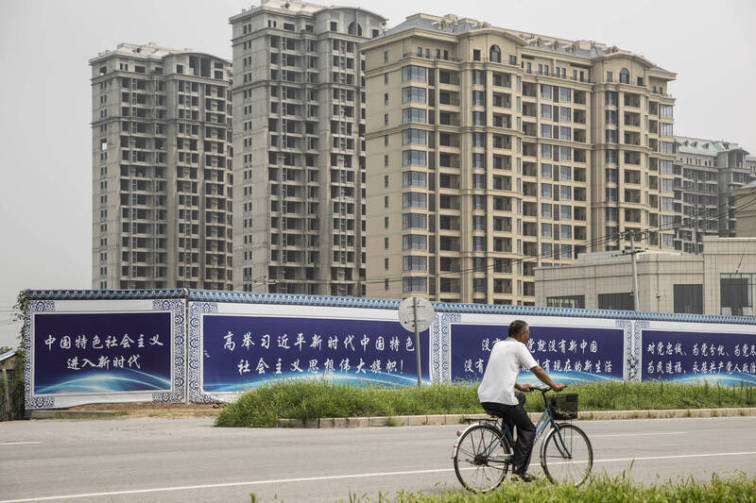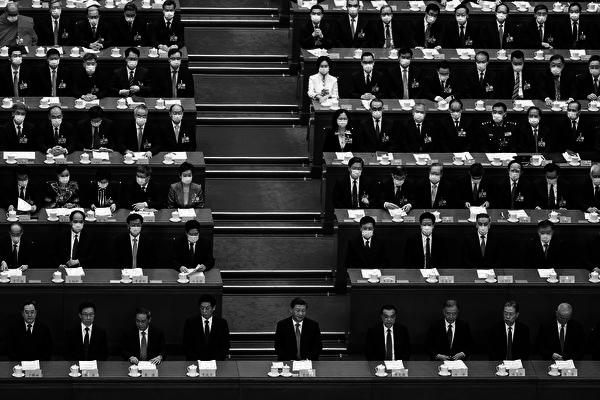Xiong'an New Area has become China’s largest unfinished construction project. (Internet photo)
[People News] Recently, Chinese Communist Party (CCP) leader Xi Jinping unexpectedly convened a high-level Central Urban Work Conference. The purpose of the meeting was to address China’s severe real estate downturn. Ten years ago, Xi Jinping was the architect behind the frenzied expansion of China’s property sector. Now that the real estate bubble has burst and crises are mounting, is this Xi’s last chance to save himself?
Why Is Xi Jinping Convening Another Urban Work Conference After 10 Years?
Historically, the CCP has held four previous urban work conferences: In September 1962 and October 1963, the first and second national urban work conferences were held to clarify the CCP’s basic stance on urban issues.
In March 1978, the State Council convened the third national urban work conference in Beijing, issuing guidelines on strengthening urban development. This came as China’s urban population was rapidly increasing due to rural and urban economic reforms.
On December 20, 2015, the CCP held the fourth urban work conference, the first in 37 years.
Now, in 2025, the fifth urban work conference has been held — ten years after the previous one.
What distinguishes this conference from those in 1978 and 2015?
Commentator Wenzhao pointed out on his program that the 1978 and 2015 meetings focused on development, whereas this one is about decline. “Given Xi Jinping’s understanding of economics, this is one of his very few remaining options — perhaps his final attempt at self-rescue,” Wenzhao said.
In the past, the CCP’s goal was to lay policy groundwork for development. Now, with China’s urbanisation nearing its ceiling, it’s searching within the cities themselves for new growth drivers to fight economic contraction.
Independent commentator Du Wen, former director of the Legal Advisory Office of the Inner Mongolia Autonomous Region Government, noted that the 2015 conference occurred at a time of booming urbanisation and real estate development. Back then, the housing market was surging — prices rose almost monthly — and China was immersed in a so-called real estate “feast.”
“Ten years later, the situation has drastically reversed. China’s real estate market is now experiencing an unprecedented slump and collapse,” Du Wen stated.
According to official data, both national real estate sales and investment have sharply declined in the past two years. Developers’ cash flow has dried up. The entire housing market is clouded by pessimism, and buyers have lost confidence. Nomura Securities reported that more than 20 million pre-sold homes across China remain undelivered.
Two Background Factors: Surging Unemployment and Falling Home Prices
Wenzhao believes that Beijing’s decision to hold another urban work conference after ten years was driven by two key issues: 1. Massive urban unemployment, a challenge not previously encountered. 2. Declining home prices, with no end in sight.
On July 17, the CCP’s National Bureau of Statistics released new data showing that youth unemployment (ages 16–24) in June stood at 14.5%, down 0.4 percentage points from May. This was the first time since August 2023 that youth unemployment figures were made public. But the numbers were immediately criticised by netizens as fake and dishonest.
In fact, Peking University researcher Zhang Dandan estimated that youth unemployment in 2023 may have reached as high as 46.5%.
HKUST professor Ding Xueliang wrote in the Hong Kong Economic Journal (March 2024) that based on experienced observers’ estimates, the actual employment rate for last year’s university graduates likely ranged from 30–35%, no more than 40%, and certainly far below the official claim of 56%. He predicted 2025 would be even worse.
What does this mean?
Wenzhao noted that a 20% unemployment rate is considered the maximum tolerable threshold for social stability. In most countries, sustained unemployment of 10–20% for several years leads to large-scale protests, unrest, visible increases in suicides and crime, and frequent government reshuffles. He cited the Greek debt crisis as a recent example.
Du Wen directly pointed the finger: the youth unemployment crisis is the inevitable result of Xi Jinping’s decade-long policy failures.
On one hand, Xi imposed heavy-handed regulation on tech platforms, cracked down on tutoring and internet industries — sectors that previously employed large numbers of young people. On the other hand, economic restructuring lagged, while private and manufacturing sectors shrank due to adverse policies. As a result, businesses struggled to survive, and young people graduating today find themselves with nowhere to go — many simply "lie flat" (give up on striving).
Wenzhao also emphasised the interconnectedness of employment and asset prices. Poor employment prospects drag down housing prices, which in turn increase banks’ non-performing loan (NPL) ratios, tighten credit, and worsen unemployment further.
China's current real estate prices and sales data can no longer be glossed over.
According to data released by the National Bureau of Statistics (NBS) of the Chinese Communist Party (CCP) on July 15, new home prices in 70 major cities fell by 0.27% in June compared to May, marking the largest monthly drop in eight months. Second-hand home prices declined 0.61% month-on-month, the biggest drop since September of last year. So far this year, housing prices have fallen 4.7% compared to the same period last year. Developers are still struggling to deal with excess housing inventory and heavy debt burdens.
Other housing-related data published by the NBS also disappointed the market. Sales of newly built homes in June dropped 12.6% year-on-year, the largest decline so far this year. In the first six months of this year, the sales value of newly built homes fell by 5.2%, a sharper drop than the 2.8% decline seen in the first five months. Real estate investment in the first half of the year declined 11.2% year-on-year, the largest drop since the COVID-19 outbreak, and worse than the 10.7% decline in the first five months.
Who Is the Original Culprit?
Du Wen believes that over the past decade, China's large-scale urban construction and the dramatic boom-and-bust of the real estate market bear Xi Jinping's personal imprint at every step. The craziness of the property market in 2015 is now mirrored by its misery in 2025.
“Ten years ago, China was building homes like dumping dumplings into boiling water. Ten years later, what’s left are mountains of unfinished buildings, and the hidden dangers have reached the point of threatening social stability.”
How Will Xi Jinping Find a Way Out?
After reading the conference materials, Du Wen sensed a strong planned economy flavour. “The official communiqué repeatedly emphasises strengthening the Party’s comprehensive leadership over urban activities. From now on, urban construction must fully obey central commands. Anyone familiar with the Chinese economy knows that this highly centralised planned economy model has long been proven inefficient and rigid,” he said.
Du Wen stated that such power centralisation comes at a heavy price — and it's ordinary people who foot the bill, not Xi Jinping. “No matter how much the people suffer, Xi won’t.”
Wenzhao, another commentator, pointed out that a major theme of this conference is shifting from expansion in quantity to improvement in quality for urban development. Specific actions include speeding up renovations of dangerous and old buildings, redeveloping urban villages, and upgrading outdated infrastructure — essentially a policy of “replacing the old with the new.”
But Wenzhao asks: Is this really for the people’s benefit, or will it cause more trouble?
He argues that if the government is pushing this campaign out of self-interest, then the execution is almost guaranteed to be harmful and disruptive to the public.
He further criticised Xi for promoting consumer “old-for-new” replacement programs as an economic stimulus tool — but Xi never stops to think: he is the ‘old’. Why can’t someone else come in and offer a ‘new’ approach? The Communist Party itself is the biggest ‘old thing’ — why not let another party bring something truly new?”
Xi’s Largest Real Estate Failure — The Xiong'an New Area
In April 2017, Xi Jinping personally approved the development plan for the Xiong'an New Area in Hebei Province. Touted as China's 19th national-level development zone, it was intended to be Beijing’s satellite city, relieving the capital’s burdens of overpopulation, housing pressure, and traffic congestion. Officially dubbed a “millennium plan”, Xiong’an was envisioned as the next Shenzhen or Pudong.
The CCP poured 610 billion yuan (about $84 billion USD) into the project — more than twice the cost of the Three Gorges Dam. Former cornfields were transformed into train stations, office towers, residential blocks, five-star hotels, schools, and hospitals. Real estate prices soared from 4,000 yuan/m² to over 40,000 yuan/m².
In 2023, a Chinese tourist drove through Xiong’an during the Lunar New Year and found a beautifully built but completely empty city. They reported, “The residential areas are nearly deserted, with an occupancy rate of only 1–2%. In a massive zone covering over 10 square kilometres, only a few shops were open. You could drive through two or three traffic lights and not see a single car. There’s basically no sign of life.”

Xiong'an has become China's largest unfinished project. (Online screenshot)
Even the so-called largest high-speed rail station in Asia, the Xiong’an station, remains eerily quiet.
When Bloomberg reporters visited Xiong’an on a weekday in January 2023, the expressway leading into the city was almost entirely empty. The city centre, lined with gleaming new government buildings, office towers, residential complexes, and hotels, had virtually no open stores or restaurants — just locked doors and shuttered windows.
Despite continued state media hype over Xiong’an’s promise, the city lacks the most crucial ingredient: people. Alfred Wu, Associate Professor at the Lee Kuan Yew School of Public Policy (National University of Singapore), noted that people are “voting with their feet” — by avoiding Xiong’an.
On May 10, 2023, Xi Jinping visited Xiong’an and chaired a meeting on its development. State media reported that Xi declared: “A high-level, modernised city is rising from the ground — a miracle!”
Indeed, Xiong’an has become one of Xi Jinping’s most spectacular governing failures — a “miracle” ghost city.
(Originally published by People News)











News magazine bootstrap themes!
I like this themes, fast loading and look profesional
Thank you Carlos!
You're welcome!
Please support me with give positive rating!
Yes Sure!